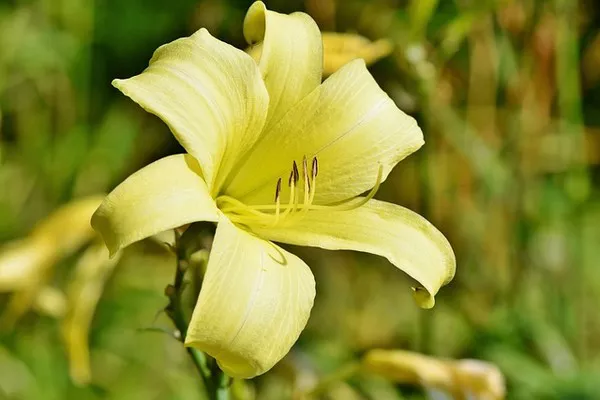The graceful presence of deer in our natural surroundings often evokes a sense of tranquility and wonder. These herbivores, known for their delicate features and gentle demeanor, have long been a subject of fascination for nature enthusiasts and wildlife admirers. However, beneath their seemingly peaceful exterior lies a voracious appetite that can have a profound impact on our gardens and natural habitats. One of the primary sources of sustenance for deer is vegetation, and in particular, flowers. In this article, we will explore the world of deer foraging habits and delve into the intriguing question: What flowers do deer really eat?
See Also: 10 Deer-Resistant Flowers to Consider
The Culinary Preferences of Deer
Deer, belonging to the family Cervidae, are herbivores with a diverse diet. While they primarily consume grasses, leaves, and woody plants, their taste for flowers cannot be underestimated. However, not all flowers are created equal in the eyes of a deer. Their culinary preferences are influenced by factors such as location, season, and the availability of other food sources.
Preferred Flowers:
a. Wildflowers: Deer often exhibit a penchant for wildflowers, which are abundant in natural habitats. Some of their favorites include aster, black-eyed Susan, coneflower, and butterfly weed. These wildflowers provide a vital source of nutrition, especially during the spring and early summer when other food options may be scarce.
b. Lilies: Lilies, with their lush and colorful blooms, are a favorite of deer. Asiatic lilies, tiger lilies, and daylilies are among the varieties that frequently fall victim to deer browsing. Gardeners in deer-prone areas should exercise caution when planting these exquisite flowers.
c. Hostas: Hostas are prized for their lush foliage and shade tolerance, making them a popular choice for garden enthusiasts. Unfortunately, deer share this admiration and often feed on hostas, especially in regions where their population is high.
d. Roses: The fragrance and beauty of roses are undeniable, and deer seem to appreciate them as well. Roses, particularly hybrid tea and floribunda varieties, are susceptible to deer damage. Gardeners may need to employ protective measures to keep their cherished rose bushes intact.
Avoided Flowers:
a. Daffodils: Daffodils, with their vibrant yellow blooms, are generally left untouched by deer. These flowers contain toxic alkaloids that deter grazing animals, making them a wise choice for deer-resistant gardens.
b. Marigolds: Marigolds are known for their pungent scent, which repels deer and other pests. Planting marigolds around your garden can serve as a natural deterrent, protecting other vulnerable flowers.
c. Lavender: The aromatic qualities of lavender make it an unappealing choice for deer. Its strong scent can mask the aroma of nearby plants, making it an effective companion in deer-prone areas.
d. Irises: Irises, with their distinctive petals and elegant appearance, are not typically on the deer menu. They are a reliable choice for gardeners looking to add a touch of elegance without inviting deer damage.
Factors Influencing Deer Flower Choices
Deer are not indiscriminate consumers of flowers; their choices are influenced by several factors:
Geographic Location: Deer populations vary across different regions, and their preferred flowers can change accordingly. Local flora and environmental conditions play a significant role in shaping their diet.
Seasonal Availability: The availability of flowers fluctuates with the seasons. During the spring and early summer, when wildflowers are in bloom, deer are more likely to indulge in a floral feast. In contrast, as winter approaches and vegetation becomes scarce, they may be compelled to nibble on less desirable plants.
Alternative Food Sources: When deer have access to an abundance of other food sources, such as grasses, leaves, and agricultural crops, they are less likely to target flowers. In times of food scarcity, however, they may resort to devouring flower beds.
Individual Preferences: Just as humans have individual taste preferences, so do deer. Some may show a greater affinity for certain flowers, while others may be more discerning in their choices.
Protecting Your Flowers from Deer
Gardeners who wish to enjoy the beauty of flowers without sacrificing them to hungry deer have several options for protection:
Fencing: Erecting a sturdy fence around your garden is one of the most effective methods for deterring deer. A fence at least 8 feet tall is typically recommended to prevent these agile creatures from leaping over.
Deer-Resistant Plants: Incorporate deer-resistant plants into your garden design. These include daffodils, lavender, and marigolds, which are less likely to be targeted by hungry deer.
Repellents: Various commercial deer repellents are available, both in liquid and granular forms. These products emit scents or tastes that are of fensive to deer, discouraging them from feeding on your flowers.
Companion Planting: Strategically planting deer-resistant flowers alongside more vulnerable varieties can help protect your garden. Marigolds, for example, can serve as a natural barrier.
Conclusion
Understanding the flower preferences of deer is essential for gardeners and land managers who want to maintain the beauty of their landscapes while coexisting with these graceful herbivores. While deer may occasionally dine on our cherished blooms, there are effective strategies to mitigate their impact and protect our floral treasures. By selecting deer-resistant plants, using repellents, and implementing fencing, we can strike a balance between our love for gardens and our respect for nature’s inhabitants. In this delicate dance between flora and fauna, we can find harmony in our shared environment.


